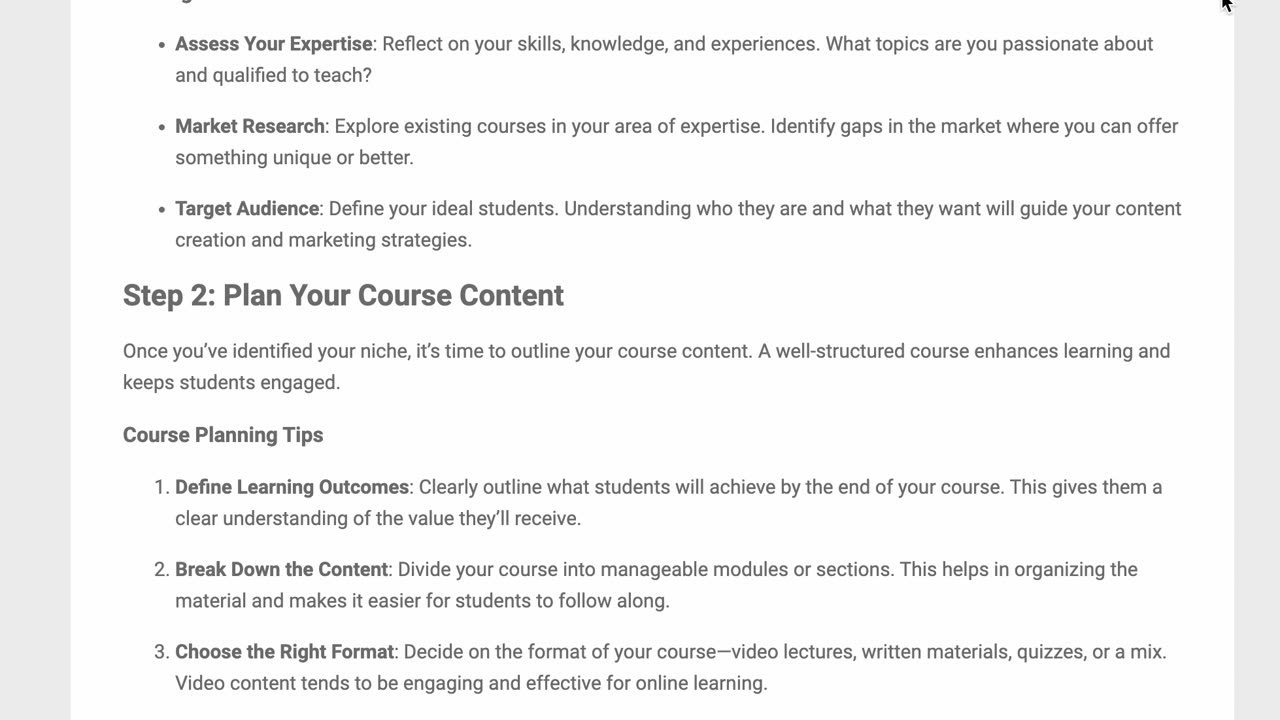Premium Only Content

How to Create and Sell Online Courses Effectively (A Comprehensive Guide)
In recent years, the demand for online courses has surged, driven by the desire for flexible learning options and the need for skill enhancement in a rapidly changing job market. Whether you’re an expert in a specific field or possess a unique skill, creating and selling online courses can be a lucrative venture. This guide will walk you through the essential steps to effectively create and market your online courses.
Understanding the Online Course Landscape
The online education market is vast, encompassing various subjects ranging from personal development and business to technical skills and creative arts. This diversity offers an excellent opportunity for educators and professionals to share their knowledge while generating income.
Why Create an Online Course?
Flexibility: You can create and sell courses on your schedule, allowing you to balance other commitments.
Passive Income: Once created, online courses can generate income without ongoing effort. This makes them an attractive option for creating passive revenue streams.
Global Reach: With the internet, you can reach students from around the world, expanding your potential customer base.
Positioning as an Expert: Creating a course helps establish you as an authority in your field, enhancing your credibility and opening doors for other opportunities.
Step 1: Identify Your Niche
Before diving into course creation, it's crucial to identify your niche. A well-defined niche helps you target your audience effectively and tailor your content to meet their needs.
Finding Your Niche
Assess Your Expertise: Reflect on your skills, knowledge, and experiences. What topics are you passionate about and qualified to teach?
Market Research: Explore existing courses in your area of expertise. Identify gaps in the market where you can offer something unique or better.
Target Audience: Define your ideal students. Understanding who they are and what they want will guide your content creation and marketing strategies.
Step 2: Plan Your Course Content
Once you’ve identified your niche, it’s time to outline your course content. A well-structured course enhances learning and keeps students engaged.
Course Planning Tips
Define Learning Outcomes: Clearly outline what students will achieve by the end of your course. This gives them a clear understanding of the value they’ll receive.
Break Down the Content: Divide your course into manageable modules or sections. This helps in organizing the material and makes it easier for students to follow along.
Choose the Right Format: Decide on the format of your course—video lectures, written materials, quizzes, or a mix. Video content tends to be engaging and effective for online learning.
Gather Resources: Consider additional resources that may enhance the learning experience, such as downloadable guides, worksheets, or supplementary readings.
Step 3: Create High-Quality Course Materials
With your content planned, it’s time to create your course materials. High-quality content is key to providing value and ensuring student satisfaction.
Tips for Creating Course Materials
Invest in Equipment: For video courses, invest in a good camera, microphone, and lighting. High-quality audio and visuals significantly improve the learning experience.
Engaging Presentation: Use engaging visuals, infographics, and clear examples in your presentations. Keep your content dynamic to maintain student interest.
Edit and Revise: Take the time to edit your materials thoroughly. Clear, concise, and error-free content reflects professionalism and enhances credibility.
Step 4: Choose a Platform for Hosting Your Course
Selecting the right platform to host your online course is crucial for its success. Various options cater to different needs and audiences.
Popular Course Platforms
Teachable: A user-friendly platform that allows you to create and sell courses with customizable features.
Udemy: A large online learning platform where you can publish your course and tap into its existing audience.
Thinkific: Offers a range of features for course creators, including customizable landing pages and marketing tools.
Considerations for Choosing a Platform
Ease of Use: Choose a platform that is easy to navigate for both you and your students.
Payment Options: Ensure the platform supports various payment methods to accommodate different customers.
Support and Resources: Look for platforms that offer robust support and resources for course creators.
Step 5: Develop a Marketing Strategy
Once your course is created and hosted, it’s time to promote it to potential students. A well-thought-out marketing strategy is essential for reaching your target audience.
Effective Marketing Strategies
Build a Website: Having your own website gives you a platform to showcase your expertise and host your course. Use it to share valuable content that draws visitors.
Content Marketing: Create blog posts, videos, or podcasts related to your course topic. This not only positions you as an expert but also drives traffic to your course.
Social Media Promotion: Utilize social media platforms to share insights about your course and engage with potential students. Instagram, Facebook, and LinkedIn can be particularly effective.
Email Marketing: Build an email list to keep your audience informed about your course launch and any special offers. Send regular updates and valuable content to maintain engagement.
Collaborate with Influencers: Partnering with influencers in your niche can help you reach a broader audience. They can promote your course to their followers, providing credibility and exposure.
Advanced Strategies for Selling Online Courses
Once your online course is live, it's time to focus on maximizing sales and enhancing student engagement. Implementing advanced strategies can help you stand out in a competitive market and improve the overall learning experience for your students.
1. Create a Sales Funnel
A sales funnel is a systematic approach to guiding potential students through the buying process. It helps convert leads into paying customers by nurturing their interest.
Steps to Create an Effective Sales Funnel
Awareness Stage: Attract potential students through engaging content, social media, and ads. This is where you introduce your expertise and the value of your course.
Consideration Stage: Provide more in-depth information about your course, including free webinars, workshops, or previews. This allows potential students to experience your teaching style.
Decision Stage: Use persuasive techniques, such as testimonials, money-back guarantees, and limited-time offers, to encourage them to make a purchase.
2. Leverage Affiliate Marketing
Affiliate marketing can be an effective way to expand your reach. By partnering with affiliates, you can tap into their audiences and increase your course sales.
How to Set Up an Affiliate Program
Choose Affiliates: Identify influencers or bloggers in your niche who align with your course content and values.
Offer Incentives: Provide affiliates with attractive commissions for every sale they generate. This motivates them to promote your course actively.
Provide Marketing Materials: Equip your affiliates with promotional materials, including banners, sample emails, and social media posts, to make it easier for them to market your course.
3. Foster Community Engagement
Creating a sense of community around your course can enhance student retention and satisfaction. Engaged students are more likely to complete the course and recommend it to others.
Strategies for Building Community
Discussion Forums: Implement discussion boards or forums where students can interact, ask questions, and share insights.
Live Q&A Sessions: Schedule regular live sessions to address student questions and provide additional insights. This personal touch helps build relationships.
Social Media Groups: Create private Facebook or LinkedIn groups for your students. This fosters connection and allows students to network with each other.
4. Gather and Utilize Feedback
Continuous improvement is key to maintaining the quality of your online course. Actively seek feedback from your students to identify areas for enhancement.
Effective Feedback Methods
Surveys and Polls: Use surveys at various stages of the course to gather feedback on content, delivery, and overall experience.
One-on-One Interviews: Consider conducting interviews with a few students to gain deeper insights into their experiences and suggestions for improvement.
Course Reviews: Encourage students to leave reviews or testimonials after completing the course. This not only provides valuable feedback but also serves as social proof for future students.
Read the full blog post here https://www.gerardyadgg.com/2024/10/how-to-create-and-sell-online-courses.html
-
 2:04:30
2:04:30
TimcastIRL
15 hours agoEpstein Files Release IMMINENT, Trump AG Says The List Is ON HER DESK w/ Will Chamberlain
222K336 -
 1:25:35
1:25:35
Roseanne Barr
20 hours ago $66.48 earnedKash Me Outside, Pedos | The Roseanne Barr Podcast #88
123K107 -
 1:21:55
1:21:55
Kim Iversen
16 hours agoMultiple States To BAN mRNA Vaccines | They Want to Make Protesting Illegal, Here's How
99.1K135 -
 7:34:25
7:34:25
Dr Disrespect
23 hours ago🔴LIVE - DR DISRESPECT - WARZONE - IMPOSSIBLE TRIPLE THREAT CHALLENGE
251K35 -
 1:02:45
1:02:45
Tundra Tactical
13 hours ago $30.59 earned🛑 KASH PATEL NEW ATF DIRECTOR??? Breaking News!!!! 🛑
103K16 -
 4:31:10
4:31:10
I_Came_With_Fire_Podcast
23 hours agoMy EURO Divorce | HOGG with a side of PAC | Foreign FUNDS Fudged
67.1K9 -
 37:44
37:44
Glenn Greenwald
20 hours agoGlenn On Tearing Down the Military Industrial Complex, Exposing Pro-Israel Indoctrination, and More | SYSTEM UPDATE #411
146K209 -
 4:04:20
4:04:20
Nerdrotic
19 hours ago $58.85 earnedAmazon Takes 007! Hollywood is Lost, Disney Cancels WHO? | Friday Night Tights 342 /w ItsAGundam
202K58 -
 43:27
43:27
Tucker Carlson
18 hours agoRay Dalio: America’s Hidden Civil War, and the Race to Beat China in Tech, Economics, and Academia
234K247 -
 56:56
56:56
Candace Show Podcast
19 hours agoEXCLUSIVE: Taylor Swift Will Be Deposed. | Candace Ep 150
259K206